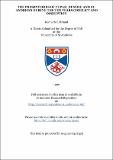Files in this item
The Presbyteries of Cupar, Dundee and St. Andrews during the ten years conflict and disruption
Item metadata
| dc.contributor.advisor | Lovegrove, D. W. | en |
| dc.contributor.author | Briand, Kenneth C. | |
| dc.coverage.spatial | iii, 328 p. | en_US |
| dc.date.accessioned | 2018-05-29T14:31:10Z | |
| dc.date.available | 2018-05-29T14:31:10Z | |
| dc.date.issued | 1992-07 | |
| dc.identifier.uri | https://hdl.handle.net/10023/13595 | |
| dc.description.abstract | The Disruption of the Church of Scotland in 1843 was arguably the most important event in Nineteenth Century Scottish religious history. The prime factor in the dispute which precipitated this crisis was the question as to whether the Church should rule itself through its own courts or be controlled by the secular government. This tension had existed in Scotland since shortly after the Reformation, but by the nineteenth century new factors had become involved. These included the political clash between democratic rights and the privilege of the ancien regime, the economic ability of Scots to maintain a church without state aid, the proper interpretation of Scots law, personal prejudice and bias especially on the part of Judges and politicians and, not least important, the transfer of civil government to the parliament in London with the consequent loss of contact with Scottish sensibilities. This study is concerned less with the detail of national events than with the reactions of local churchmen, both clerical and lay, to the events which occurred between 1830 and 1850. It focuses on three adjacent but dissimilar presbytery areas: the industrial area of Dundee where the leaders of public opinion were the entrepreneurial and professional members of the rising middle classes; the largely rural area of St. Andrews where public attitudes were formed by landowners and university professors; and the Cupar Presbytery area where agriculture and industry co-existed and where landowners and the middle classes shared responsibility for the general climate of opinion. This diversity of views is explored in the study as also are the reactions of various groups (e.g. , laity, clergy, students) to the judgements of the civil court concerning the Veto Act and to the campaigns for non-intrusion and spiritual Independence mounted by Church leaders. The contrasting responses of the three presbyteries to the allied issue of the Chapel Act are examined, while local preparations for the Disruption are explored in detail and set in the national context. The final sections of the study are devoted to a careful examination of the local aftermath of the Disruption: the manner in which the three Established presbyteries responded to their loss of ministers and elders and their attempts to recover their earlier social dominance; the ways in which the Free Church developed during the post Disruption years; the differences between the social and economic characteristics of those ministers and elders who adhered to the Established Church and those who joined the Free Church. | en_US |
| dc.language.iso | en | en_US |
| dc.publisher | University of St Andrews | |
| dc.subject.lcc | BX9072.D5B8 | en |
| dc.subject.lcsh | Church of Scotland--History--19th century | en |
| dc.title | The Presbyteries of Cupar, Dundee and St. Andrews during the ten years conflict and disruption | en_US |
| dc.type | Thesis | en_US |
| dc.type.qualificationlevel | Doctoral | en_US |
| dc.type.qualificationname | PhD Doctor of Philosophy | en_US |
| dc.publisher.institution | The University of St Andrews | en_US |
This item appears in the following Collection(s)
Items in the St Andrews Research Repository are protected by copyright, with all rights reserved, unless otherwise indicated.

